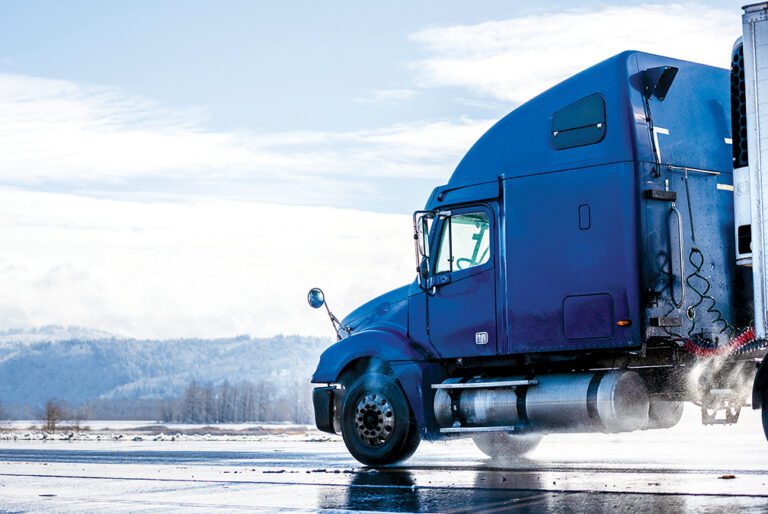Depending on where you are in North America, spring may be just around the corner. While pleasant days, sunshine and blooming wildflowers can bring tranquility to a hectic schedule, spring is also a time of weather extremes that can cause devastation to unsuspecting drivers.
In many areas it can seem like the season changes several times in a day. Balmy temperatures in the daytime can drop to below freezing at night. Rain showers or thunderstorms can turn into sleet, snow or freezing rain. Dry highways can become treacherous in a matter of hours.
Understanding weather patterns is helpful in predicting what’s coming. High- and low-pressure systems on a weather map are often confusing diagrams of letters and crooked lines. To make sense of them, it’s helpful to form the mental picture of a hurricane (a hurricane, or typhoon in other parts of the world, is mostly a low-pressure system on steroids).
Low-pressure systems in the Northern hemisphere rotate in a counterclockwise direction. Everyone has seen TV footage of hurricanes, hundreds of miles wide, as they approach coastal areas. Low-pressure systems, however, cross the continent on a nearly daily basis. Because they aren’t spinning as fast or sucking up water like hurricanes do from the ocean, they aren’t as easy to spot on satellite footage — but they’re there.
As it spins across the continent, the first part of a low-pressure system pulls up warm air from the South. As the rear of the system crosses, it brings down cold, dry air from the North. Since cooler air is denser, the warmer air is pushed upward, where it forms thunderclouds and brings precipitation.
Now, imagine that giant hurricane-shaped low-pressure system is immediately followed by a high-pressure system, spinning in the opposite (clockwise) direction. The area where the two systems collide, often hundreds of miles long, is called a front. That front is often the area where bad weather happens, including thunderstorms, tornadoes, blizzards and more.
It’s common for stormy periods to be followed by cold snaps. In the North, this often means the weather warms up and snow falls, followed by days of sub-zero temperatures. In the South, it’s rain followed by cool, dry weather. In-between — and there is a LOT of in-between — anything can happen.
Because weather conditions can change so rapidly, it’s important to have the latest weather information and stay informed. It can be even more important in spring and fall, when temperatures often hover around freezing. Wet roads can quickly become icy, especially on bridges and overpasses. That’s because the ground radiates heat that help keeps road surfaces warm enough not to freeze; bridges don’t have ground underneath.
Road clearing and de-icing operations are sometimes lax in spring and fall, too. When a heavy snowfall is predicted, crews are prepared and often start treating road surfaces before the snow starts to fall. When rain is predicted, it’s more difficult to predict whether freezing will occur. If the decision is made to apply them, de-icing chemicals are quickly washed from the roadway.
Drivers should be as prepared as possible for icy roads in these conditions. Fortunately, up-to-date weather information is available through GPS systems, smartphones and special channels on some CB radios and other sources. Some phone services send alerts when dangerous conditions develop. Drivers who typically run with the CB turned off might want to leave it on to get the latest information about the road ahead.
There are ways to tell if the road surface ahead might be freezing. Noting whether nearby vehicles are fishtailing or having traction problems is an obvious way to tell. A common procedure used by many drivers is to look for road spray coming off the tires of other vehicles, especially trucks. If there’s no spray, there’s a good chance the water on the roadway is frozen.
At times, visible ice can form on mirror brackets and antennas. Antennas that are coated with ice often react differently in the vehicle’s wind stream. Normally they might move back and forth in response to vehicle movement. If they begin moving side-to-side or in a circular pattern, there may be ice buildup, so reduce speed.
Some northern states enact frost laws in spring, and many are strongly enforced. During the winter, the ground beneath the road freezes. In the spring, however, rain or melt-water can seep through cracks and imperfections in the pavement. Since the ground beneath is still frozen, it can’t soak this water up and a layer can form under the pavement. This water layer can allow the road surface to “flex” as a heavy vehicle passes, causing new pavement cracks to form. The result is quick deterioration.
Interstate and other highways designed for heavy-duty use often have thicker subsurface materials and pavement, making frost laws unnecessary. For trips that involve smaller state, county or local roads, drivers should be prepared to select an alternate route.
When weather conditions make the roads treacherous, consider shutting down. Just as conditions can deteriorate quickly, they can improve quickly as the front passes or the sun warms the road surface. Instead of trying to proceed at slower speeds, it may be better use of time to rest now and drive later, when the roads are clear.
In any event, the old adage that no load is worth your life or well-being certainly applies when roads are dangerous. Be prepared, and make wise decisions.
Cliff Abbott is an experienced commercial vehicle driver and owner-operator who still holds a CDL in his home state of Alabama. In nearly 40 years in trucking, he’s been an instructor and trainer and has managed safety and recruiting operations for several carriers. Having never lost his love of the road, Cliff has written a book and hundreds of songs and has been writing for The Trucker for more than a decade.














